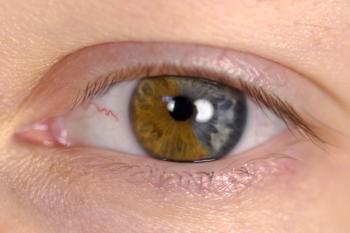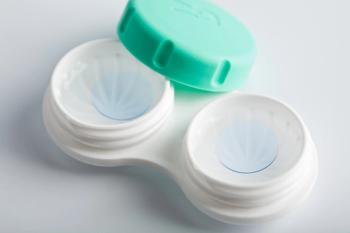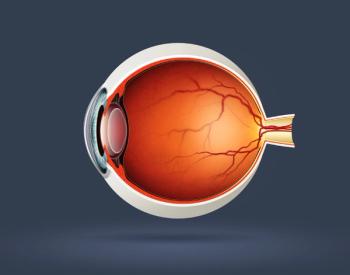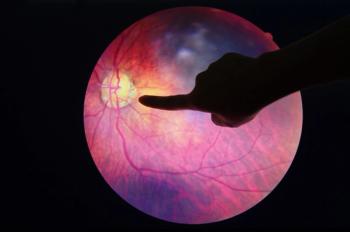
The lipid dioleoyl-phosphatidylglycerol accelerates healing of corneal epithelial wounds, according to a study published in Investigative Ophthalmology & Visual Science.


The lipid dioleoyl-phosphatidylglycerol accelerates healing of corneal epithelial wounds, according to a study published in Investigative Ophthalmology & Visual Science.

Implanting intraocular lenses (IOLs) after cataract surgery in infants is neither beneficial nor detrimental to long-term visual outcomes, according to a study published in JAMA Ophthalmology.

Visual impairment may be a risk factor for dementia, according to a study published in JAMA Ophthalmology in which researchers compared the likelihood of incident dementia or mild cognitive impairment among women with and without baseline visual impairment.

We're sending patients eye charts via email, doing zoom visits or telehealth visits by video or audio– it's been interesting to see that ophthalmologists can adapt to to this. I think that's going to be something that will stay on in some way, shape, or form after this pandemic subsides, said Sonal Tuli, MD, Clinical Spokesperson for the American Academy of Ophthalmology (AAO).

In a new study published in Contact Lens & Anterior Eye, ocular scientists offer guidance for practitioners about contact lens and spectacle use during the coronavirus disease 2019 (COVID-19) pandemic.

Firework-related ocular injuries occur most often in individuals who are young, male, and white, according to study results published in JAMA Ophthalmology.

Anterior and posterior ocular structure changes occur in astronauts who complete long-term spaceflights, according to a study published in JAMA Ophthalmology.

Researchers analyzed data from 38 patients with COVID-19 from Hubei Province, China, and found 12 individuals had ocular manifestations, including epiphora, conjunctival congestion, or chemosis.

Researchers at the University of British Columbia in Canada found eye movements may precede hand movements in certain actions that require a 2-step decision-making process, according to a study published in the Journal of Neurophysiology.

Investigators used virtual reality to better understand the particular vision difficulties of patients with glaucoma.

Researchers were able to effectively use an arm-mounted optical coherence tomography angiography (OCTA) device to learn information about the developing fovea in extreme low birth weight (ELBW) neonates, according to a study published in the American Journal of Ophthalmology.

The number of US adults at high risk for vision loss increased from 2002 to 2017, according to an observational study based on national survey data.

Utilizing the latest information provided by the World Health Organization and CDC on the novel coronavirus, COVID-19, the American Academy of Ophthalmology issued a set of guidelines recommending protection for the mouth, nose, and eyes when caring for patients potentially infected with the virus.

Substantial medication and follow-up nonadherence exists among inmates with glaucoma, according to a study published in JAMA Ophthalmology.

Cataract surgery was associated with an increase in melatonin secretion, according to new study findings; melatonin secretion has been linked to depression, diabetes, cognitive impairment, and breast cancer.

Researchers developed a structurally colored contact lens sensor with tunable colors to assist in point-of-care diagnoses of common eye diseases, according to a study published in the Journal of Materials Chemistry B.

There’s significant evidence that some patients with far-advanced glaucoma are able to perform more tasks than others. Yet, it’s difficult to distinguish these patients from each other. A new study proposes a way to find out.

Finely tuned eye movements are instrumental in enhancing visual acuity, according to findings of a study published in Nature Communications.

New research confirms that end-stage renal disease is a significant risk factor for patients undergoing cataract surgery.

Using whole genome sequencing, researchers were able to determine genetic heterogeneity in patients with optic nerve hypoplasia (ONH), according to a study published in PLoS One.

A transcriptome-wide association study found 106 genes that may point to the pathogenesis of age-related macular degeneration, according to results recently published in Scientific Reports.

The incidence of open globe injuries decreased in the US from 2006 to 2014, according to a recent study published in JAMA Ophthalmology.

Researchers in Canada determined that a treat-and-extend regimen of administering ranibizumab to patients with neovascular age-related macular disease produced comparable results to a monthly dosing administration, according to a study published in JAMA Ophthalmology.

Following cataract surgery, a submicron formulation of loteprednol etabonate (LE) gel, 0.38% administered three times daily (TID), is safe and effective for treating ocular inflammation with minimal risk of intraocular pressure (IOP) elevation, according to study findings.

Teprotumumab, which was approved this week by the FDA, resulted in a greater frequency of proptosis reduction compared with placebo for patients with active thyroid eye disease, according to study results released Wednesday.

259 Prospect Plains Rd, Bldg H
Cranbury, NJ 08512
© 2025 MJH Life Sciences®
All rights reserved.
